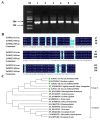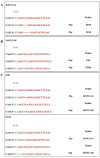TaWI12 may be involved in pistillody and leaf cracking in wheat
- PMID: 39875850
- PMCID: PMC11776163
- DOI: 10.1186/s12870-025-06133-5
TaWI12 may be involved in pistillody and leaf cracking in wheat
Abstract
TaWI12 is a member of the wound-induced (WI) protein family, which has been implicated in plant stress responses and developmental processes. Wheat (Triticum aestivum L.) is a crucial staple crop upon which human sustenance relies. Consequently, investigating the developmental mechanisms of pistils and stamens in wheat is profoundly significant for enhancing wheat characteristics and boosting productivity. In this study, we cloned TaWI12, from common wheat and observed a significant resemblance among the three homoeologs of TaWI12. The open reading frames (ORFs) of TaWI12-4A, TaWI12-4B and TaWI12-4D were 408 bp, 417 bp and 417 bp, respectively, and encoded 135, 138 and 138 amino acids, respectively. The phylogenetic tree revealed a high degree of homology between the protein sequences of TaWI12 and the wound-induced proteins of Hordeum vulgare (KAI4994568) and Aegilops tauschii (XP_020196548). To clarify the characteristics and functions of TaWI12 homoeologs, we obtained transgenic positive plants of Arabidopsis thaliana and observed significant filament shortening and decrease. Simultaneously, we used the CRISPR/Cas9 system to generate mutant plants via the modification of three homoeologs of TaWI12 in wheat. We noticed two distinct phenotypic differences in the knockout mutant. First, we observed the different degrees of homologous conversion of stamens to pistils in the single mutant TaWI12-4D. Second, we observed leaf cracking in both the single mutant TaWI12-4A and the double mutants TaWI12-4A and TaWI12-4D. Our findings further revealed that TaWI12 plays an important role in flower development, which is important for revealing the molecular mechanisms of pistil and stamen development in wheat and has important application value for high-yield wheat breeding.
Keywords: TaWI12; Filament shortening; Flower development; Pistillody; Wheat.
© 2025. The Author(s).
Conflict of interest statement
Declarations. Ethics approval and consent to participate: not applicable. Consent for publication: not applicable. Competing interests: The authors declare no competing interests. Clinical trial number: not applicable.
Figures






References
-
- Carlsson J, Leino M, Sohlberg J, et al. Mitochondrial regulation of flower development [J]. Mitochondrion. 2008;8(1):74–86. 10.1016/j.mito.2007.09.006. - PubMed
-
- Al-Gburi SAH, Al-Gburi BKH. Improving the nutritional content of wheat grains by integrated weeds management strategies and spraying with nano-micronutrients [J]. J Saudi Soc Agricultural Sci. 2023;23(1):88–92. 10.1016/j.jssas.2023.09.005.
-
- Qiu YL, Chen HQ, Zhang SX, et al. Development of a wheat material with improved bread-making quality by overexpressing HMW-GS 1Slx2. 3* from Aegilops longissima [J]. Crop J. 2022;10(6):1717–26. 10.1016/j.cj.2022.04.001.
-
- United Nations. (2019) World Population Prospects 2019: Highlights. In: Statistical Papers - United Nations (Ser. A), Population and Vital Statistics Report (Vol. ST/ESA/SER.A/423).
-
- Le Bourgot C, Liu XX, Buffière C, et al. Development of a protein food based on texturized wheat proteins, with high protein digestibility and improved lysine content [J]. Food Res Int. 2023;170:112978. 10.1016/j.foodres.2023.112978. - PubMed
MeSH terms
Substances
LinkOut - more resources
Full Text Sources

